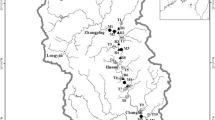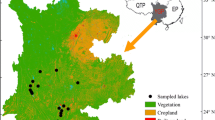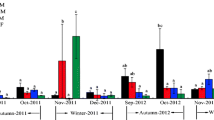Abstract
Nitrous oxide (N2O) is one of the main greenhouse gases, which contributes to the global warming and ozone destruction. Sediment cores and river water were collected from an urban and a suburban river for N2O efflux measurement at the sediment-water interface and the factor-controlled incubations to investigating the N2O effluxes under varying conditions of dissolved oxygen (DO), ammonium (NH4 +), nitrate (NO3 −) and sulfate (SO4 2−). Vertical profiles of dissolved N2O concentrations in pore water were also acquired at eight depths. Results show that N2O effluxes were higher at the urban site (13.01 ± 6.51 μg N m−2 h−1) than the suburban site (4.02 ± 2.01 μg N m−2 h−1). Oxygen consumption rates were optimal under high DO and NH4 + amendment incubation, highlighting the strong nitrification potential in the sediment surface. Although N2O effluxes at the urban site increased with the NO3 − concentration under low DO condition, DO and NH4 + concentrations in overlying water were the principal factors controlling N2O effluxes (R = −0.415, p = 0.000 and R = 0.512, p < 0.05, respectively), indicating that nitrification greatly contributed to N2O production, especially at suburban river. Generally, N2O efflux was substantially higher in the severely polluted urban river, and the sediments were the source of N2O in river water.





Similar content being viewed by others
References
Barnard R, Leadley P, Hungate BA (2005) Global change, nitrification, and denitrification: a review. Global Biogeochemical Cycles 19:2282–2298
Beaulieu JJ, Arango CP, Hamilton SK, Tank JL (2008) The production and emission of nitrous oxide from headwater streams in the Midwestern United States. Global Change Biology 14:878–894
Beaulieu JJ, Arango CP, Tank JL (2009) The effects of season and agriculture in nitrous oxide production in headwater streams. Jounal of Environmental Quality 38:637–646
Beaulieu JJ, Shuster WD, Rebholz JA (2010) Nitrous oxide emissions from a large, impounded river: the Ohio River. Environmental Science & Technology 44:7527–7533
Beaulieu JJ, Tank JL, Hamilton SK, Wollheim WM, Hall RO Jr, Mulholland PJ, Peterson BJ, Ashkenas LR, Cooper LW, Dahm CN, Dodds WK, Grimm NB, Johnson SL, Mcdowell WH, Poole GC, Valett HM, Arango CP, Bernot MJ, Burgim AJ, Crenshaw CL, Helton AM, Johnson LT, O’Brien JM, Potter JD, Sheibley RW, Sobota DJ, Thomas SM (2011) Nitrous oxide emission from denitrification in stream and river networks. PNAS 108:214–219
Buljan M (1951) Note on a method for determination of ammonia in sea water. Journal of the Marine Biological Association of the United Kingdom 30:277–280
Butler JH, Elkins J (1991) An automated technique for the measurement of dissolved N2O in natural waters. Marine Chemistry 34:47–61
Casciotti KL, Mcilvin M, Buchwald C (2010) Oxygen isotopic exchange and fractionation during bacteria ammonia oxidation. Limnology and Oceanography 55:753–762
Casro-González M, Farías L (2004) N2O cycling at the core of the oxygen minimum zone off northern Chile. Marine Ecology Progress Series 280:1–11
Clough TJ, Buckthought LE, Kelliher FM, Sherlock RR (2007) Diurnal fluctuations of dissolved nitrous oxide (N2O) concentrations and estimates of N2O emissions from a spring-fed river: implications for IPCC methodology. Global Change Biology 13:1016–1027
Conrad R (1996) Soil microorganisms as controllers of atmospheric trace gases (H2, CO, CH4, OCS, N2O, and NO). Mircrobiological Reviews 60:609–640
Gardner WS, McCarthy MJ, An S, Sobolev D (2006) Nitrogen fixation and dissimilatory nitrate reduction to ammonium (DNRA) support nitrogen dynamics in Texas estuaries. Limnology and Oceanography 51:558–568
Garnier J, Beusen A, Thieu V, Billen G, Bouwman L (2010) N: P: Si nutrient export ratios and ecological consequences in coastal seas evaluated by the ICEP approach. Global Biogeochemical Cycles 24. doi:10.1029/2009GB003583
Goreau TJ, Kaplan WA, Wofsy SC, McElroy MB, Valois FW, Watson SW (1980) Production of NO2 − and N2O by nitrifying bacteria at reduced concentrations of oxygen. Applied and Environmental Microbiology 40:526–532
Gribsholt B, Boschker HTS, Struyf E (2005) Nitrogen processing in a tidal freshwater marsh: a whole-ecosystem 15N labeling study. Limnology and Oceanography 50:1945–1959
Hinshaw S, Dahlgren R (2013) Dissolved nitrous oxide concentrations and fluxes from the Eutrophic San Joaquin River, California. Environmental Science & Technology 47:1313–1322
IPCC (2007) (Contribution of Working Group I to the Fourth Assessment Report of the Intergovernmental Panel on Climate Change). Climate change 2007: the physical science basis. Cambridge University Press, Cambridge, 996 pp
Jäger N, Stange CF, Ludwig B, Flessa H (2011) Emission rates of N2O and CO2 from soils with different organic matter content from three long-term fertilization experiments-a laboratory study. Biology Fertility of Soils 47:483–494
Kartal B, Maalcke WJ, de Almeida NM, Cirpus I, Gloerich J, Geerts W, Op den Camp HJM, Harhangi HR, Janssen-Megens EM, Francoijs K, Stunnenberg HG, Keltjens JT, Jetten MSM, Strous M (2011) Molecular mechanism of anaerobic ammonium oxidation. Nature 479:127–130
Krug FJ, Růžička J, Hanen H (1979) Determination of ammonia in low concentrations with Nessler’s reagent by flow injection analysis. Analyst 104:47–54
Ligi T, Truu M, Oopkaup K, Nõlvak H, Mander Ü, Mitsch WJ, Truu J (2015) Genetic potential of N2 emission via denitrification and ANAMMOX from the soils and sediments of a created riverine treatment wetland complex. Ecological Engineering 80:181–190
Liu XL, Liu CQ, Li SL, Wang FS, Wang BL, Wang ZL (2011) Spatiotemporal variations of nitrous oxide (N2O) emissions from two reservoirs in SW China. Atmospheric Environment 45:5458–5468
Mander Ü, Well R, Weymann D, Soosaar K, Maddison M, Kanal A, Lõhmus K, Truu J, Augustin J, Tournebize J (2014) Isotopologue ratios of N2O and N2 measurements underpin the importance of denitrification in differently N-loaded riparian alder forests. Environmental Science and Technology 48(20):11910–11918
Marty D, Michotey V, Bonin P (2011) Dynamics of two greenhouse gases, methane and nitrous oxide, along the rhone river plume (Gulf of Lions, Northwestern Mediterranean Sea). Global Change: Mankind-Marine Environment Interactions 6:377–383
Megonigal JP, Hines ME, Visscher PT (2003) Anaerobic metabolism: linkages to trace gases and aerobic processes. Treatise on Geochemistry 8:317–424
Meyer RL, Allen DE, Schmidt S (2008) Nitrification and denitrification as sources of sediment nitrous oxide production: a microsensor approach. Marine Chemistry 110:68–76
Miller LG, Oremland RS, Paulsen S (1986) Measurement of nitrous oxide reductase activity in aquatic sediments. Applied and Environmental Microbiology 51:18–24
Morse JL, Ardón M, Bernhardt ES (2012) Using environmental variables and soil processes to forecast denitrification potential and nitrous oxide fluxes in coastal plain wetlands across different land uses. Journal of Geophysical Research 117:G2. doi:10.1029/2011JG001923
Mulholland PJ, Helton AM, Poole GC, Hall RO, Hamilton ST, Peterson BJ, Tank JL, Ashkenas LR, Cooper LW, Dahm CN, Dodds WK, Findlay SEG, Gregory SV, Geimm NB, Johnson SL, McDowell WH, Meyer JL, Valett HM, Webster JR, Arango CP, Beaulieu JJ, Bernot MJ, Burgin AJ, Crenshaw CL, Johnson LT, Niedelehner BR, O’ Brien JM, Potter JD, Sheibley RW, Sobota DJ, Thomas SM (2008) Stream denitrification across biomes and its response to anthropogenic nitrate loading. Nature 452:202–205
Naqvi SWA, Jayakumar DA, Narvekar PV, Naik H, Sarma VVSS, D’Souza W, Joseph S, George MD (2000) Increased marine production of N2O due to intensifying anoxia on the Indian continental shelf. Nature 408:346–349
Risgaard-Petersen N (2003) Coupled nitrification-denitrification in autotrophic and heterotrophic estuarine sediments: on the influence of benthic microalgae. Limnology and Oceanography 48:93–105
Rosamond MS, Thuss SJ, Schiff SL (2012) Dependence of riverine nitrous oxide emissions on dissolved oxygen levels. Nature Geoscience 5:715–718
Seitzinger SP (1988) Denitrification in freshwater and coastal marine ecosystems: ecological and geochemical significance. American Society of Limnology and Oceanography 33:702–724
Seitzinger SP, Kroeze C (1998) Global distribution of nitrous oxide production and N inputs in freshwater and coastal marine ecosystems. Global Biogeochemical Cycles 12:93–113
Seitzinger SP, Pilson MEQ, Nixon S (1983) Nitrous oxide production in nearshore marine sediments. Science 222:1244–1245
Teixeira C, Magalhães C, Boaventura RAR, Bordalo AA (2010) Potential rates and environmental controls of denitrification and nitrous oxide production in a temperate urbanized estuary. Marine Environmental Research 70:336–342
Trimmer M, Risgaard-Petersen N, Nicholls JC (2006) Direct measurement of anaerobic ammonium oxidation (anammox) and denitrification in intact sediment cores. Marine Ecology Progress Series 326:37–47
Wang SL, Liu CQ, Yeager KM, Wan GJ, Li J, Tao FX, Lǚ YC, Liu F, Fan CX (2009) The spatial distribution and emission of nitrous oxide (N2O) in a large eutrophic lake in eastern China: anthropogenic effects. Science of the Total Environment 407:3330–3337
Weiss RF, Price BA (1980) Nitrous oxide solubility in water and seawater. Marine Chemistry 8:347–359
Wrage N, Velthof GL, van Beusichem ML, Oenema O (2001) Role of nitrifier denitrification in the production of nitrous oxide. Soil Biology and Biochemistry 33:1723–1732
Yan WJ, Yang LB, Wang F, Wang J N, Ma P (2012) Riverine N2O concentrations, exports to estuary and emissions to atmosphere from the Changjiang River in response to increasing nitrogen loads. Global Biogeochemical Cycles 26. doi:10.1029/2010GB003984
Yeomans JC, Bremner JM (1988) A rapid and precise method for routine determination of organic carbon in soil. Communications in Soil Science and Plant Analysis 19:1467–1476
Yu ZJ, Deng HG, Wang DQ, Ye MW, Tan YJ, Li YJ, Chen ZL, Xu SY (2013) Nitrous oxide emissions in the Shanghai river network: implications for the effects of urban sewage and IPCC methodology. Global Change Biology 19:2999–3010. doi:10.1111/gcb.12290
Zhu GB, Wang SY, Wang WD, Wang Y, Zhou LL, Jiang B, Op den Camp HJM, Risgaard-Petersen N, Schwark L, Peng YZ, Hefting MM, Jetten MSM, Yin CQ (2013) Hotspots of anaerobic ammonium oxidation at land-freshwater interfaces. Nature Geosciences 6:103–107
Acknowledgments
This work was jointly supported by the National Natural Science Foundation of China (Grant No.40903049, Grant No. 41301221 and Grant NO. 41473094), Natural Science Foundation of Shanghai Municipality (Grant NO.14ZR1412100), and the Fundamental Research Funds for the Central Universities. We acknowledge S. Lin and Y. Qi for their assistance with field work and in the laboratory.
Author information
Authors and Affiliations
Corresponding author
Rights and permissions
About this article
Cite this article
Wang, D., Tan, Y., Yu, Z. et al. Nitrous Oxide Production in River Sediment of Highly Urbanized Area and the Effects of Water Quality. Wetlands 35, 1213–1223 (2015). https://doi.org/10.1007/s13157-015-0708-5
Received:
Accepted:
Published:
Issue Date:
DOI: https://doi.org/10.1007/s13157-015-0708-5




